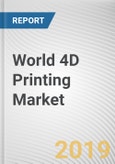The 4D printing market is segmented based on application into various sectors such as Military & defense, Manufacturing, Automotive, Medicine, Infrastructure, Construction, Clothing and Aerospace. According to Hansal, the technology also has potential in areas such as biology, construction, robotics, space exploration and transportation.
Key Benefits
The analysis of the global market provides an overview of the global 4D printing market with special reference to market trends, market structure, limiting factors and opportunities
Porters Five Forces model is used to analyze the potential of buyers & suppliers, and the competitive structure of the market, to guide the market players to develop effective strategies
Assessments are made according to the current business scenario and the future market structure & trends are forecast for the period 2013-2020 considering 2013 as the base year
The global market is analyzed in a comprehensive manner to help the stakeholders identify the key market opportunities
Value chain analysis provides a systematic study on the key intermediaries involved, which would in turn help the stakeholders to make appropriate strategies
KEY MARKET SEGMENTS
The global applications market is segmented based on various applications such as Military & defense, Automotive, Medicine, Construction, Manufacturing, Infrastructure, Clothing and Aerospace.
MARKET BY APPLICATIONS
Military & defense
Automotive
Medicine
Construction
Manufacturing
Infrastructure
Clothing
Aerospace
MARKET BY GEOGRAPHY
North America
Europe
Asia Pacific
View Also :
World 3D Printing Market - Opportunities and Forecasts 2014 - 2020
Methodology
The analyst offers exhaustive research and analysis based on a wide variety of factual inputs, which largely include interviews with industry participants, reliable statistics, and regional intelligence. The in-house industry experts play an instrumental role in designing analytic tools and models, tailored to the requirements of a particular industry segment. The primary research efforts include reaching out participants through mail, tele-conversations, referrals, professional networks, and face-to-face interactions.
They are also in professional corporate relations with various companies that allow them greater flexibility for reaching out to industry participants and commentators for interviews and discussions.
They also refer to a broad array of industry sources for their secondary research, which typically include; however, not limited to:
- Company SEC filings, annual reports, company websites, broker & financial reports, and investor presentations for competitive scenario and shape of the industry
- Scientific and technical writings for product information and related preemptions
- Regional government and statistical databases for macro analysis
- Authentic news articles and other related releases for market evaluation
- Internal and external proprietary databases, key market indicators, and relevant press releases for market estimates and forecast
Furthermore, the accuracy of the data will be analyzed and validated by conducting additional primaries with various industry experts and KOLs. They also provide robust post-sales support to clients.

LOADING...








